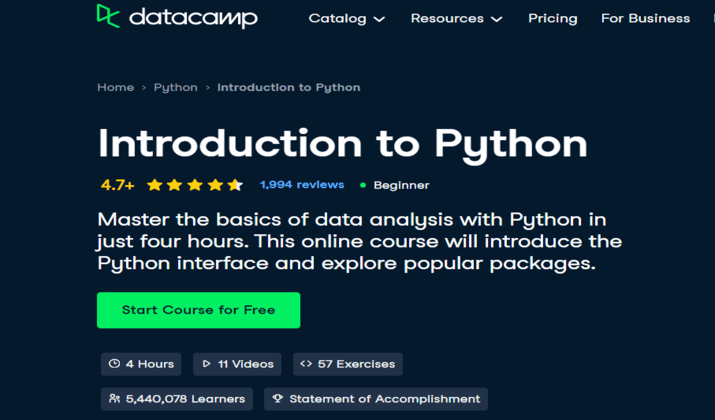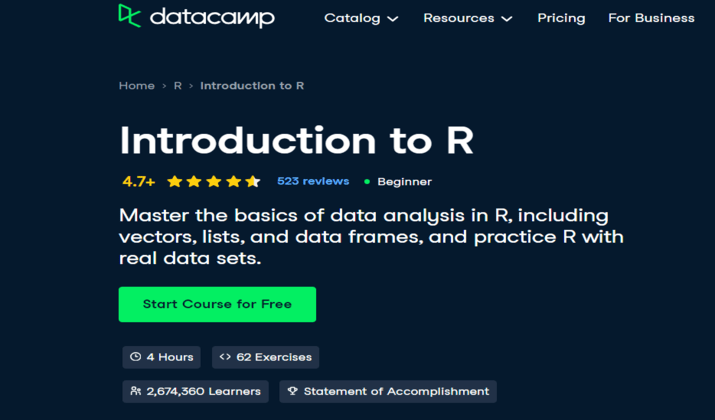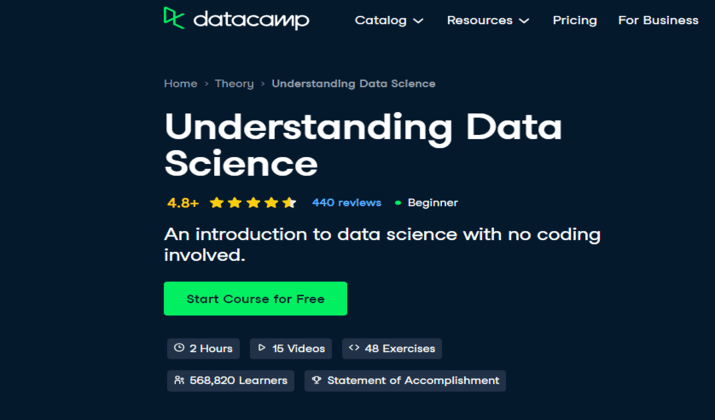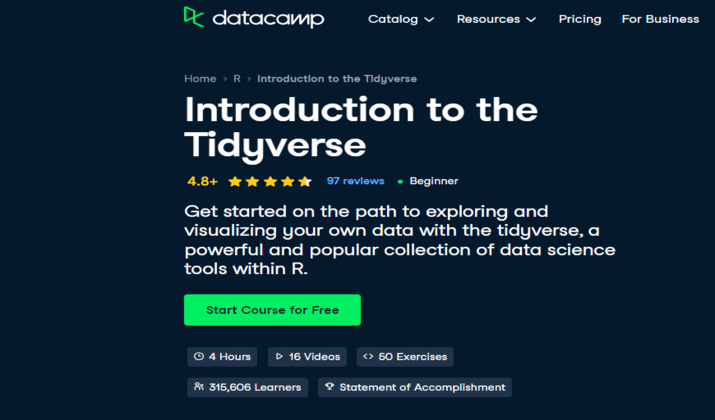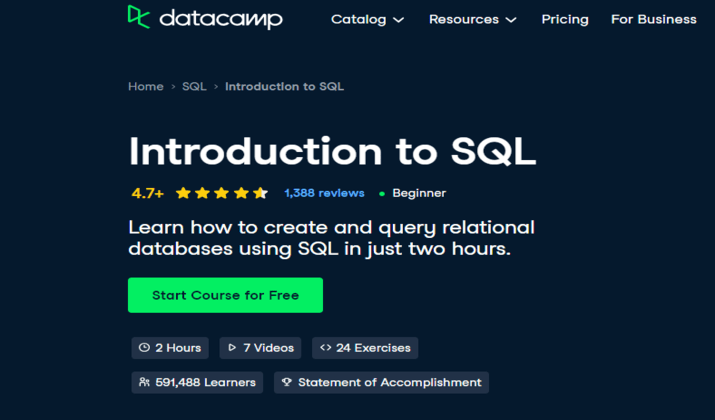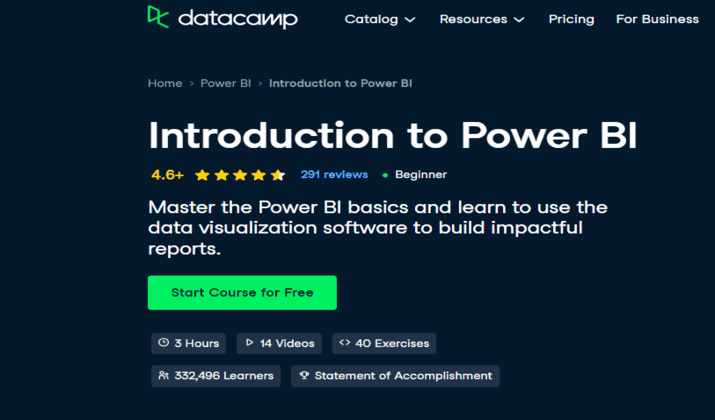Get Started with DataCamp for FREE.The place to learn R, Python & Data Science. Check Special Pricing.
Let’s get started.
Best DataCamp Courses
1. Introduction to Python: Master the Fundamentals of Data Analysis
The “Introduction to Python” course is the perfect starting point for anyone eager to learn the fundamentals of Python. The course introduces you to the basics of this programming language and its applications in data analysis.
The course is led by Hugo Bowne-Anderson, a renowned data scientist at DataCamp. It provides a comprehensive introduction to Python and covers essential concepts such as:
- Basic syntax
- Data manipulation
- Analysis techniques
With over 5 million successful enrollments and a remarkable rating of 4.7, this course has earned an impressive reputation as one of the most popular and highly recommended choices for beginners in the field of data analysis.
Get Started with DataCamp for FREE.The place to learn R, Python & Data Science. Check Special Pricing.
Through interactive exercises and real-world examples, you will gradually gain hands-on experience and develop a solid foundation in Python programming for data analysis.
2. Introduction to R: Explore the Power of R for Statistical Analysis
If you’re interested in delving into the world of statistical analysis using R, the “Introduction to R” course offered by DataCamp is an excellent choice.
Taught by Jonathan Cornelissen, co-founder of DataCamp, this course provides a comprehensive introduction to R and its powerful capabilities for data visualization and analysis.
R is a highly versatile programming language that is widely used in the field of data science for its robust statistical capabilities. Learning R will equip you to:
- Harness its power to analyze and visualize data
- Perform complex statistical calculations
- Generate insightful visualizations
Throughout the course, you will learn the basics of R programming, including data structures, functions, and control flow. You will also explore R’s extensive collection of packages, which provide additional tools and functions for various statistical analysis tasks.
If you’re looking to enhance your data science skills and take your statistical analysis abilities to the next level, the “Introduction to R” course is a valuable resource that can help you achieve your goals.
Check out: DataCamp vs Skillshare – Which is better?
3. Exploring Data Science: Gain a Comprehensive Understanding of Data Science
The “Understanding Data Science” course offered by DataCamp is designed to provide you with a comprehensive understanding of the core concepts and methodologies used in data science.
This course, taught by Sara Billen and two other experienced instructors, covers a wide range of topics essential for data science enthusiasts.
Key aspects of this course include:
- Data exploration: This allows you to gain insights and extract valuable information from various datasets. Through hands-on exercises and real-world examples, you’ll learn how to effectively explore and analyze data to uncover patterns and trends.
- Data visualization: This vital component of the course enables you to communicate insights and findings in a visual and compelling manner. You’ll discover different visualization techniques and tools to present your data effectively, making it easier for others to interpret and understand.
- Predictive modeling: Moreover, the course features predictive modeling, that will teach you how to build models that can make accurate predictions based on historical data. This skill is particularly valuable in fields like finance, healthcare, and marketing, where data-driven decision-making is crucial.
With over 431,000 enrollments, this course has been highly regarded by learners from various backgrounds. It holds an impressive rating of 4.8, reflecting its quality content and effectiveness in delivering a comprehensive understanding of data science.
You might find this useful: DataCamp vs Udemy – Which is better?
4. Introduction to the Tidyverse: Dive into the Tidyverse Ecosystem in R
Get Started with DataCamp for FREE.The place to learn R, Python & Data Science. Check Special Pricing.
The “Introduction to the Tidyverse” course offers a comprehensive exploration of the Tidyverse ecosystem within R. Taught by David Robinson, this course equips you with the knowledge and skills to develop efficient data workflows and harness the full potential of the Tidyverse.
The Tidyverse is a collection of powerful packages that facilitate:
- Data manipulation
- Data visualization
- Data analysis
The Tidyverse ecosystem in R includes popular packages like dplyr, ggplot2, tidyr, and purrr, among others. These packages provide intuitive and consistent tools for data manipulation, making it easier to clean, transform, and visualize data.
With over 278,000 enrollments and a rating of 4.8, the “Introduction to the Tidyverse” course has received rave reviews from learners.
Whether you’re new to R or an experienced user, this course is highly recommended for anyone interested in data manipulation and analysis in R. By mastering the Tidyverse, you can streamline your data analysis process and produce high-quality insights.
Another interesting read: DataCamp vs Dataquest – Which is best?
5. Introduction to SQL: Master the Basics of Querying and Manipulating Databases
The “Introduction to SQL” course offered by DataCamp is the perfect opportunity for you to master the basics of SQL, the structured query language used for querying and manipulating databases.
Taught by Izzy Weber, a seasoned expert in SQL, this course basically covers a wide range of topics essential for anyone working with structured data.
As you progress through the course, you will learn how to:
- Extract data from databases
- Manipulate and transform data using SQL statements
- Gain a deep understanding of database concepts such as tables, columns, and relationships
Whether you’re a beginner or have some experience with SQL, this course will provide you with the knowledge and skills needed to effectively work with databases and extract valuable insights.
One of the key focuses of the “Introduction to SQL” course is teaching you how to query databases effectively. Besides. The course will equip you with skills that include:
- How to write SQL queries to retrieve specific information from databases
- Filter data based on conditions, sort and order data
- Perform calculations on data to generate meaningful results
- Use this powerful language to solve real-world data problems
- Make data-driven decisions
Whether you’re interested in data analysis, business intelligence, or data engineering, SQL is an essential skill that will open up a world of opportunities for you.
With over 239,000 enrollments and a rating of 4.7, the “Introduction to SQL” course has certainly received high praise from learners like you.
Joining this course can help unlock your potential to query databases, manipulate data, and derive valuable insights that can drive your career forward.
Read this too: Datacamp vs Brilliant – Which is better?
6. Introduction to Power BI: Create Interactive Dashboards with Power BI
The world of data visualization and analytics has been undoubtedly revolutionized by the advent of Power BI. With its powerful features and user-friendly interface, Power BI has become a go-to tool for creating interactive dashboards and reports.
Sara Billen and Iason Prassides lead the course on “Introduction to Power BI” course. During the course, you’ll learn how to harness the full potential of Power BI to visualize and analyze your data.
The skills you will pick up during the course are as follows:
- The art of data modeling
- How to effectively transform raw data into meaningful insights
- Hands-on experience in utilizing various visualization techniques to present your findings in a visually appealing manner
- Understand importance of well-designed dashboards
- Best practices for creating intuitive and user-friendly dashboards that convey information effectively
With over 231,000 enrollments and a rating of 4.6, this course has garnered praise from data analysts around the world.
By the end of this course, you’ll be also equipped with the skills to build powerful interactive dashboards. This is integral to enable informed decision-making and drive data-backed strategies.
Conclusion
With a range of courses designed for both beginners and experienced professionals, DataCamp equips you with the skills and knowledge needed to succeed in the field of data science.
Whether you want to delve into Python and R for data analysis, master SQL for querying databases, or create interactive dashboards with Power BI, DataCamp has courses tailored to your specific needs.
Led by industry experts like Hugo Bowne-Anderson, Jonathan Cornelissen, and Sara Billen, these courses certainly offer comprehensive instruction. In addition the courses also provide hands-on exercises, and real-world case studies.
Enroll in DataCamp courses today and empower yourself with the tools and expertise necessary to excel in the ever-evolving data-driven landscape.


